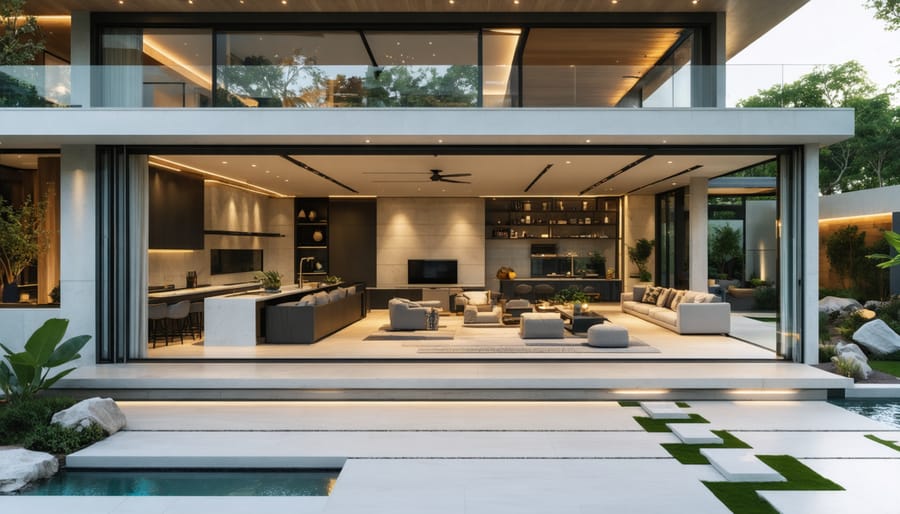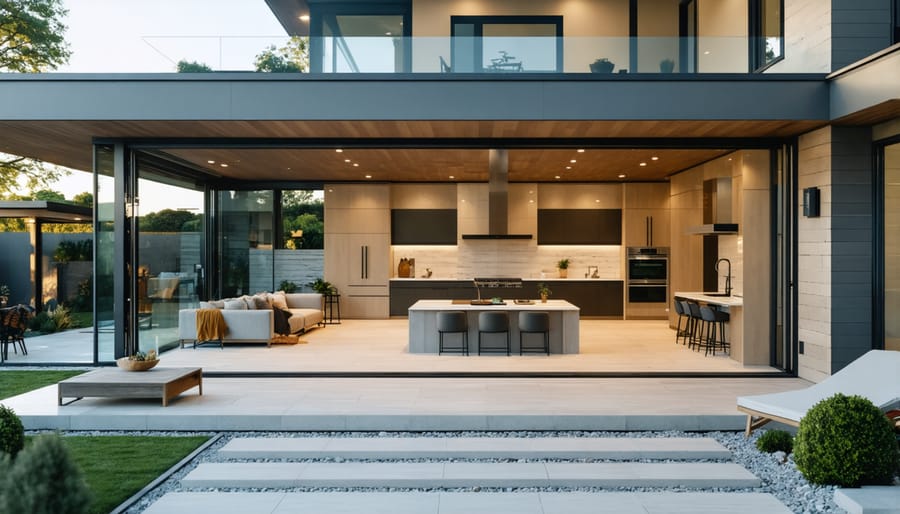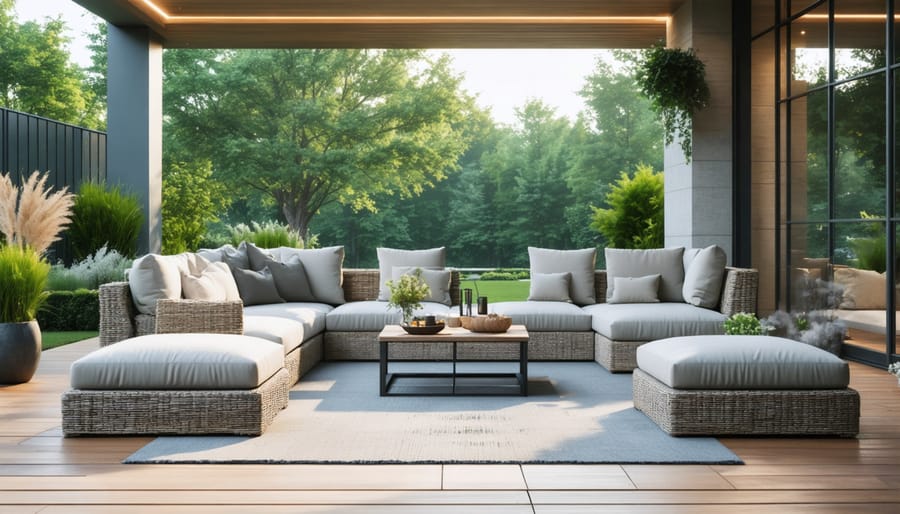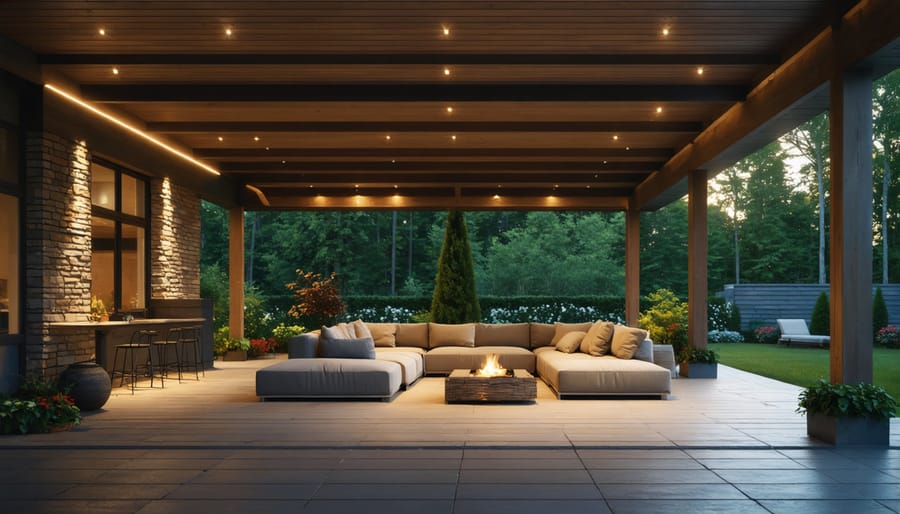
Transform your living space by blending indoor comfort with outdoor freedom through seamless transitions and strategic design choices. Incorporating biophilic design principles creates a harmonious flow between interior and exterior spaces, maximizing natural light and establishing a continuous visual connection with nature. Modern indoor/outdoor living spaces have evolved beyond simple patios into sophisticated extensions of the home, featuring weather-resistant materials, versatile furniture arrangements, and architectural elements that blur traditional boundaries.
These hybrid spaces serve as year-round sanctuaries, offering the perfect balance between sheltered comfort and open-air living. Whether hosting gatherings that spill from kitchen to garden or creating a peaceful retreat for daily living, thoughtfully designed indoor/outdoor spaces enhance property value while delivering the increasingly sought-after lifestyle benefits of flexible, multi-functional environments. By carefully considering climate control, material selection, and spatial flow, homeowners can create seamless transitions that maximize their property’s potential and create living areas that truly respond to modern lifestyle needs.
The seamless integration of indoor and outdoor spaces relies heavily on thoughtful architectural elements that blur the boundaries between these areas. Sliding glass doors serve as the primary gateway, with modern options including multi-panel systems that stack or disappear completely into wall pockets when opened. These door systems not only provide easy access but also create an unobstructed view that makes both spaces feel unified.
Large windows play an equally crucial role, extending sight lines and allowing natural light to flood interior spaces. Floor-to-ceiling windows or window walls create the illusion of bringing the outdoors in, even when physical barriers are necessary. Strategic window placement can frame outdoor views like living artwork, making them focal points of interior rooms.
Floor-level continuity is essential for achieving a truly cohesive space. Using the same or complementary flooring materials that transition smoothly from inside to outside helps eliminate visual barriers. Popular options include weather-resistant porcelain tiles, composite decking that mimics interior wood floors, or natural stone that flows seamlessly between spaces. The key is maintaining consistent elevation levels and ensuring proper drainage where indoor and outdoor surfaces meet.
These architectural elements work together to create a harmonious transition that enhances both the functionality and aesthetic appeal of your living space. When properly designed and installed, they provide year-round enjoyment while maintaining necessary protection from the elements.

Selecting the right weather-resistant materials is crucial for creating a seamless transition between indoor and outdoor spaces. High-performance fabrics like Sunbrella and solution-dyed acrylics offer exceptional durability while maintaining a luxurious feel that rivals traditional indoor textiles. For furniture frames, powder-coated aluminum provides excellent rust resistance and lightweight functionality, while teak and marine-grade stainless steel offer timeless appeal with minimal maintenance requirements.
To maintain design cohesion, consider using similar color palettes and textures across both spaces. Natural stone flooring or porcelain tiles that mimic wood can flow seamlessly from interior to exterior areas, creating visual continuity. Modern composite decking materials offer the warmth of wood with enhanced durability and lower maintenance needs.
For accent pieces and architectural elements, consider materials like tempered glass, which can withstand temperature fluctuations while maintaining transparency, and concrete, which can be finished to complement both indoor and outdoor aesthetics. Performance fabrics for cushions and upholstery should feature UV-resistant properties and quick-drying capabilities without sacrificing comfort or style.
Remember to select materials that not only withstand the elements but also age gracefully. Many contemporary materials are engineered to maintain their appearance with minimal intervention, allowing you to focus on enjoying your space rather than maintaining it.

Selecting furniture that seamlessly transitions between indoor and outdoor spaces is crucial for creating a cohesive living area. The key lies in choosing pieces that combine durability with style while maintaining functionality in both environments.
Weather-resistant materials like teak, powder-coated aluminum, and high-performance wicker offer excellent versatility. These materials withstand outdoor elements while maintaining an sophisticated appearance suitable for interior spaces. Modern manufacturing techniques have made it possible to create pieces that look equally at home in your living room or on your patio.
Consider modular seating arrangements that can be easily reconfigured based on your needs. Sectional sofas with weather-resistant upholstery can be separated to create intimate seating areas indoors or combined for larger outdoor gatherings. Storage ottomans serve triple duty as seating, storage solutions, and occasional tables while being easily movable between spaces.
Nesting tables and stackable chairs are particularly valuable for dual-purpose settings. These pieces can be compactly stored when not needed or expanded to accommodate additional guests. Look for designs with wheels or lightweight construction for easy mobility.
Many manufacturers now offer coordinated indoor/outdoor collections that maintain consistent styling throughout your space. These collections often include dining sets, lounging furniture, and accent pieces that share design elements while featuring materials appropriate for both environments.
For maximum versatility, select neutral colors and timeless designs that complement both interior and exterior décor schemes. Adding personality through interchangeable cushions and accessories allows you to update the look seasonally while maintaining the furniture’s dual functionality.
Protecting furniture in transitional spaces requires a strategic approach to combat both indoor and outdoor elements. Start by selecting durable fabric selections specifically designed for indoor/outdoor use, which resist fading, mildew, and water damage while maintaining their aesthetic appeal.
Regular cleaning is essential – establish a weekly maintenance routine that includes dusting surfaces, spot-cleaning fabrics, and checking for early signs of wear. During extreme weather conditions, consider relocating more delicate pieces to fully protected areas or using high-quality furniture covers designed to allow airflow while preventing moisture buildup.
Apply protective treatments appropriate for your furniture’s materials. Wood pieces benefit from seasonal resealing to prevent moisture damage, while metal furniture should receive anti-rust treatments before humid seasons. For upholstered items, refresh water-repellent sprays every three to six months, depending on exposure levels.
Monitor humidity levels in your transitional space, as fluctuations can affect wooden furniture’s integrity. Install proper ventilation systems and consider using dehumidifiers during particularly muggy periods. In winter, protect furniture from direct contact with cold surfaces by using furniture pads or risers.
Store cushions and decorative elements in weather-resistant containers when not in use, particularly during severe weather events. Consider investing in modular furniture pieces that can be easily moved or reconfigured based on weather conditions. By implementing these protective measures, you’ll significantly extend the life of your indoor/outdoor furniture while maintaining its appearance and functionality throughout the seasons.
Effective lighting design is crucial for creating a seamless transition between indoor and outdoor spaces. Natural light should be maximized through strategic placement of windows, sliding glass doors, and skylights. Consider installing oversized windows or floor-to-ceiling glass panels to blur the boundaries between interior and exterior spaces while flooding your living area with daylight.
For artificial lighting, layered illumination creates depth and functionality. Incorporate a mix of ambient, task, and accent lighting to maintain consistency across both spaces. Modern smart lighting solutions allow you to adjust brightness and color temperature throughout the day, matching the natural light cycle and creating the perfect ambiance for any occasion.
Outdoor lighting deserves equal attention to ensure usability after sunset. Install weather-resistant fixtures that complement your interior lighting scheme. Path lights, wall sconces, and strategic uplighting of landscaping elements create visual continuity while ensuring safety. Consider installing dimmable LED strip lighting under steps or along railings to define transitions between spaces.
For covered outdoor areas, ceiling fans with integrated lighting provide both illumination and comfort. Solar-powered accent lights offer eco-friendly alternatives for highlighting architectural features and garden elements, while ensuring your outdoor space remains inviting and functional well into the evening hours.

Creating adaptable indoor/outdoor living spaces that shine year-round requires thoughtful planning and seasonal adjustments. During warmer months, lightweight, moisture-resistant furniture and bright, summery accessories can transform your space into a vibrant entertainment area. Consider incorporating removable shade solutions like retractable awnings or umbrellas to provide comfort during peak sunlight hours.
As temperatures cool, transition your space with weather-resistant cushions in warmer tones and add outdoor heating elements such as fire pits or mounted heaters. Weatherproof storage solutions become essential for protecting cushions and decor during harsh weather conditions. Installing proper lighting becomes crucial during shorter winter days – consider string lights, LED lanterns, or integrated lighting systems that create ambiance while ensuring safety.
Spring and fall are ideal times for deep cleaning and maintenance of your indoor/outdoor furniture. Regular inspection and treatment of wooden elements help prevent weather damage, while metal pieces may need rust prevention care. Consider incorporating portable elements that can be easily moved between indoor and outdoor spaces as needed, such as rolling bar carts or modular seating arrangements.
For year-round functionality, invest in quality furniture covers and establish a seasonal maintenance schedule. Creating designated storage areas for off-season items helps maintain organization while protecting your investment in outdoor furnishings.
Maintaining furniture in indoor/outdoor living spaces requires a strategic approach to protect against both interior and exterior elements. The key to longevity lies in regular inspection and proactive care, especially for pieces that experience varying environmental conditions.
For wooden furniture, apply a quality sealant every six months to prevent moisture damage and warping. Choose marine-grade products for optimal protection, particularly for items closer to outdoor areas. During humid seasons, use dehumidifiers to maintain optimal moisture levels and prevent mold growth on upholstery and wooden surfaces.
Metal furniture requires special attention to prevent rust and corrosion. Apply a protective coating at the start of each season and inspect regularly for signs of oxidation. Touch up any chips or scratches immediately to prevent deterioration. For coastal areas, consider powder-coated furniture options, which offer superior resistance to salt air and humidity.
Fabric care is crucial in hybrid spaces. Select performance fabrics designed for indoor/outdoor use, and treat them with fabric protector spray every three months. Remove cushions during severe weather and store them in a dry location. Regular vacuuming and prompt stain treatment will extend the life of upholstered pieces.
Create a maintenance schedule that includes weekly cleaning with appropriate products for each material type. During seasonal transitions, conduct thorough inspections and address any issues immediately. Consider using furniture covers during extreme weather conditions, even in partially enclosed spaces.
For delicate or valuable pieces, rotate their position periodically to ensure even exposure to environmental conditions. Keep trees and plants trimmed to prevent sap and debris from damaging furniture surfaces. Install proper drainage systems to prevent water accumulation near furniture placement areas.
Professional cleaning and restoration services annually can help identify potential issues before they become significant problems, ensuring your indoor/outdoor living space remains beautiful and functional throughout the year.
Creating a seamless indoor/outdoor living space represents more than just a design trend – it’s an investment in your lifestyle and property value. Throughout this guide, we’ve explored the essential elements that make these hybrid spaces successful, from strategic furniture placement to weather-resistant material selection and proper maintenance routines.
By implementing the design principles and practical tips discussed, you can transform your transitional space into a year-round haven that perfectly balances comfort with functionality. Remember that the key to success lies in thoughtful planning, selecting appropriate materials, and maintaining a cohesive design that flows naturally between indoor and outdoor areas.
Whether you’re starting with a blank canvas or looking to enhance an existing space, begin by assessing your specific needs and local climate conditions. Consider incorporating multi-functional furniture pieces that can adapt to different occasions and weather patterns. Don’t forget to factor in proper protection for your furnishings to ensure their longevity and preserve their appearance.
Take the first step today by sketching your ideal layout and creating a prioritized action plan. Start with one area at a time, gradually building your perfect indoor/outdoor retreat. With proper planning and maintenance, your hybrid living space will provide years of enjoyment while adding significant value to your property. Transform your vision into reality and create the seamless living environment you’ve always dreamed of.